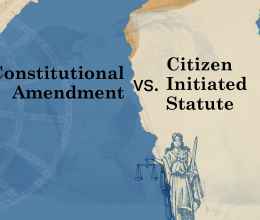The goal of all youth legal systems is to ensure youth are given a developmentally appropriate chance to right their wrongs and move into adulthood on a more positive track. Our “Purpose of the Youth Justice System” blog highlighted that Ohio was an early innovative presence in the development of the youth legal system, however, the outcomes for Ohio’s youth are concerning. In Ohio, approximately 40% of youth return to the Department of Youth Services (DYS) or local youth legal facilities within three years after their initial release back to the community. In theory, legally involved should be treated differently than adults, but Ohio’s policies and practices when it comes to our youth don’t always align with this guidance.
We have a chance in Ohio right now to transform our system, and it starts with Governor DeWine’s Juvenile Justice Working Group and their blueprint for meaningful, systemic reform.
Other Youth Justice Models
Missouri
Missouri’s youth legal system has been revered as the “Missouri Miracle” yielding less than 9% recidivism from their legally involved youth. This legal model relies heavily on rehabilitation of youth and is relationship centered, providing practical skills to prepare for positive integration back into their communities. The Missouri youth legal system is made up of small, community-based facilities that hold youth in closely supervised small groups where the youth's physical and emotional safety is paramount. Positive adult relationships, peer-relational skills, and genuine emotional safety are cultivated through the community and culture of the facilities. Highly trained staff provide programming that assists in developmental, educational, and vocational skills in preparation for the youth's release.
This model also centers the youth's family unit as a highly valued asset for successful reintegration post-release. Lastly, Missouri’s Division of Youth Services provides extensive case management of legally involved youth, highlighting the importance of structured support in the first few weeks following a youth's introduction back to the community. Overall, Missouri’s model utilizes small facilities, therapeutic and rehabilitative practices, and a culture of respect and dignity for both youth and staff that specifically excludes solitary confinement and use of force.
Pennsylvania
Pennsylvania’s, decentralized, county-based model revolves around the idea of balanced and restorative justice (BARJ) which emphasizes the importance of meaningful care for youthful offenders to protect the community and produce youth who positively interact with society after their release.
In Pennsylvania, their Juvenile Advisory Committee developed the Juvenile Justice System Enhancement Strategy (JJSES) to bridge the gap between policy and practice for their youth courts, detention facilities, and interactions with community partners. The JJSES centers research-informed, best practices to approach three central areas of juvenile rehabilitation: community protection, competency development, and accountability. Their goals include prioritizing diversion of youth whenever possible, meeting the needs of victims, and involving youth’s families at every level of legal system contact.
In the early 2000’s, Pennsylvania was chosen as a pilot program state for the Juvenile Justice and Delinquency Prevention Committee (JJDPC) and McArthur Foundation’s Models for Change Initiative which allowed for an acceleration of positive reform in their youth legal system. The initiative outlined clear goals for the state including structured aftercare for released youth, screening/assessment and mental healthcare, diversion strategies, and minimizing disproportionate minority contact. As of 2019, Pennsylvania’s youth legal system boosted a recidivism rate of 11.7%.
Tennessee
Tennessee’s youth justice model prioritizes diversion in the form of Child and Family courts, mandated programming, and functional interventions like therapy and behavioral health services. They also rely heavily on aftercare for youth who have made contact with the criminal legal system. Tennessee’s system is decentralized, and counties have high amounts of control regarding where youthful offenders go and how long they must serve. Their stated goals include deinstitutionalizing status offenders, removing children from adult jails and keeping youth offenders separate from adult offenders, and minimizing disproportionate minority contact. As of 2023, Tennessee’s youth recidivism rate was 14.7%.
Specifically, in Davidson County, their juvenile justice center practices pretrial diversion and strict home detention to foster community safety while recognizing how traumatic it can be for youth to be detained. They perform pretrial risk assessments, provide structured re-entry services, and individualized care for individual offenders. In the early 2010’s, Judge Sheila Calloway called for reform within the Davidson County Juvenile Court and with the assistance of the Office of Juvenile Justice and Delinquency Prevention, brought in the Criminal Justice Institute to deliver trainings on the Principles of Effective Intervention and Cognitive Interaction Skills for their probation staff, as well as highlighted eight staff members to become certified trainers on this topic in order to integrate the ideals into the processes of the court.
Future of Ohio’s Youth Legal System
Over the last year, Governor DeWine convened a Juvenile Justice Working Group that evaluated Ohio’s DYS youth prisons and overall efficacy of the juvenile legal system. The Working Group reported that youth in state-run facilities had poor outcomes during their stay and after release, as well as significant dysfunction within the facilities themselves.
The Working Group then proposed a list of recommendations to reform Ohio’s youth legal system including:
- A systemic shift to smaller, community-based facilities to hold youth;
- Addressing the need for behavioral health services;
- Helping youth reintegrate after release;
- Implementing staff-wellness programs to address the quality and retention of staff.
Some of these recommendations are already in the process of being implemented, however others will require further political courage to create the best possible outcomes for Ohio’s youth. Systemic transformation towards smaller, local facilities as well as increased oversight within the JDCs has already begun, however increasing funding for new local Community Corrections Facilities (CCFs) and evaluating then changing harmful policies like mandatory bindover specifications, gun-related adjudication requirements, and minimum age for youth commitment to DYS require action and approval from the General Assembly. States like Missouri and Pennsylvania provide a roadmap to transformational reform our youth justice system requires, and our kids deserve.
At the ACLU of Ohio, we believe youth deserve the chance to be positive members of their communities, and they have the right to assistance, support, and rehabilitation. We know there is a better path forward for Ohio’s youth, and we will continue to highlight and speak out against unjust practices that negatively impact our youth, families, and communities as well as uplift policies that treat all kids as kids.








